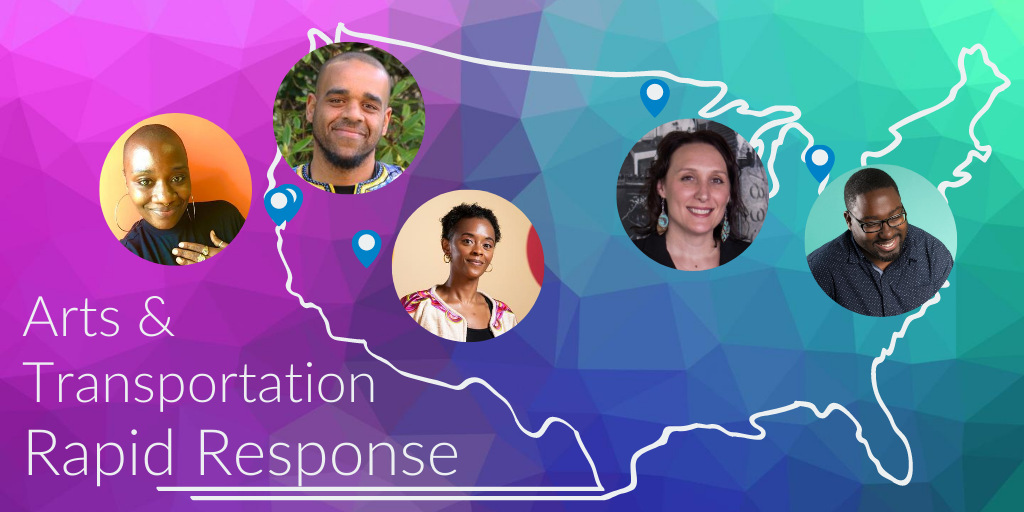
News
By Ben Stone, November 9, 2020
Facing incredible challenges during the pandemic, the creative practices of artists have helped five transportation agencies better respond to the rapidly changing demands related to public space, getting around safely, mask wearing, social distancing, and communicating about rules and regulations changing daily. Coming this week, we’ll be publishing five stories about our Arts and Transportation Rapid Response initiative.

In partnership with Forecast Public Art and with funding from the Kresge Foundation and the National Endowment for the Arts, Smart Growth America (SGA) launched the Arts & Transportation Rapid Response initiative during the summer of 2020 in the middle of the world’s worst pandemic in more than a generation. The project sought to partner transportation agencies with artists to develop creative solutions to COVID-related transportation challenges, with the hypothesis that artists’ creative practices would enhance agencies’ responses to quickly shifting new demands related to mask wearing, social distancing, and communicating rapidly changing rules and regulations.
After issuing an open call for proposals, SGA received an unprecedented number of applications—almost 200—and selected five agencies to receive funding. Each of the selected projects committed to addressing COVID-related transportation challenges and systemic inequities and to do so in unique, creative ways, with the support of local artists. SGA and Forecast curated five artists to partner with five agencies, who were selected through a nationwide open call for artists, conversations with local arts nonprofits and arts councils, and the review of artists’ portfolios.
Read the five stories here as they are published:
- Monday: Jonathan Brumfield and the Oakland Department of Transportation
- Tuesday: Ndubisi Okoye and the City of Detroit
- Wednesday: Ashley Hairston Doughty and the Regional Transportation Commission of Southern Nevada
- Thursday: Tosha Stimage and the San Francisco Bay Area Rapid Transit (BART)
- Friday: Naomi RaMona Schliesman and the West Central Initiative (WCI)
Five different projects, but consistent throughlines
Despite the disparate locations and contexts, there were many throughlines that connected the work. Each artist faced the challenge of starting by soliciting input from the community members who would be impacted by their work. While community engagement is often a challenging part of most transportation projects, the quick pace of the initiative and COVID’s limitations on in-person meetings made engagement particularly challenging.
The projects all used art and design to alter behavior and make transportation users safer in a range of ways; from wayfinding signs, to clearly articulating mask regulations, the artists conveyed rapidly changing, confusing, and often political messages in culturally specific and community relevant ways, often with a focus on the dignity of the transportation users.
And finally, though the transportation agencies had a range of experience working with artists in the past, each had to learn how to bring their partnered artist up to speed on complex internal approval and installation processes, just as the artists each had to learn how to use their skills and limited budgets to impact massive, bureaucratic systems.
Lessons for artists, lessons for transportation agencies
A few recurring themes and lessons emerged from each of the five projects: Each artist began their work by addressing the monumental challenge of soliciting input from a community in the midst of a pandemic that has made in-person meetings nearly impossible. In response to this reality, the artists found that they had to substitute online meetings, surveys, and one-on-one (masked, socially distant, and outdoors) meetings in place of larger group meetings. Additionally, the project team members found that the pilot projects themselves became an effective form of engagement; by producing something quickly and unveiling the work before it was finalized, the pilot projects then solicited input from the community in the form of people expressing their feelings about the pilot projects. In fact, this input was much more valuable than input on an abstract project idea, since people were able to respond to something tangible.
The project teams also learned that there are benefits and challenges to working at such a rapid pace. On one hand, the rapid pace allowed for helpful information and new safety protocols to be communicated at an appropriately quick pace. On the other hand, some teams learned that their attempts to circumvent some processes for the sake of moving quickly were not actually feasible, resulting in additional time needed to implement the projects.
Finally, each artist played a crucial role as a translator for their partner agencies. Because the artists were members of the communities served by the transportation agencies, the artist brought local opinions and needs into the agencies, both supportive and skeptical. After becoming familiar with the agencies, they also took on the role of translating the agencies’ work and decision-making processes to their neighbors and community members. This dissolving of the us-versus-them/community-versus-agency dynamic helped each of the five teams create more effective and meaningful work.
Check back—we'll be publishing a story each day this week, beginning with Jonathan Brumfield and the Oakland Department of Transportation.
Related News

© 2025 Smart Growth America. All rights reserved
Site By3Lane Marketing










